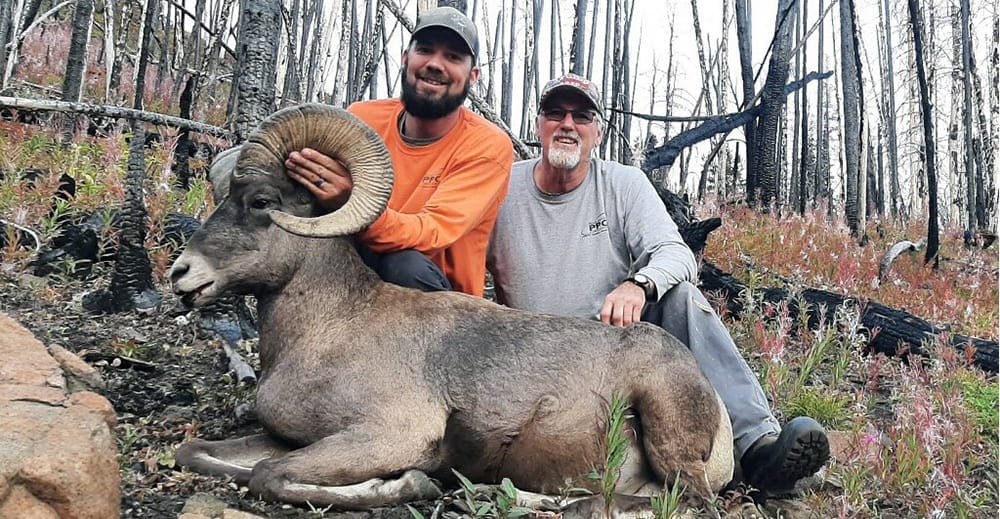
(L-R) Michael Bost shares his hunt of a lifetime with his dad, Dennis.
IBEW Member’s Wait for Rocky Mountain Bighorn Sheep Hunt Pays Off
Backcountry hunting comes with risks
by Kurt Beckstrom
USA member Michael Bost of Powell, Wyoming, waited 19 years to draw one of his state’s coveted Rocky Mountain bighorn sheep tags, but his lifelong dream was nearly derailed just days before his hunt.
It’s not unusual that state residents must accumulate preference points well into the double digits for a chance at a sheep tag. Each year, state biologists set a harvest quota for each of the 18 areas. Last fall’s bighorn sheep demand report shows that a successful draw required at least 17 points in one of the areas while other areas required 25 or 26 points. (Hints for Drawing a Tag of a Lifetime)
“I started putting in for preference points in 2002, when I was 14,” said the IBEW Local 322 member. “My dad had explained the point and draw system and how it took many years to finally get enough points to draw a tag for certain big game animals.”
What keeps hunters enthused about applying year after year, Bost explained, is the unlikely possibility of getting drawn for one of the few random tags that don’t require preference points. “Even though you know there could be thousands of people applying,” he said, “and that only one or two random tags would be available in your area, there’s always hope that you might be one of the lucky ones.”
As Bost grew up, he and his father Dennis successfully hunted elk and deer. In 2011, they hunted mountain goat when Bost’s name was pulled in the random drawing for that species. “He’s been my hunting partner my whole life,” he said.
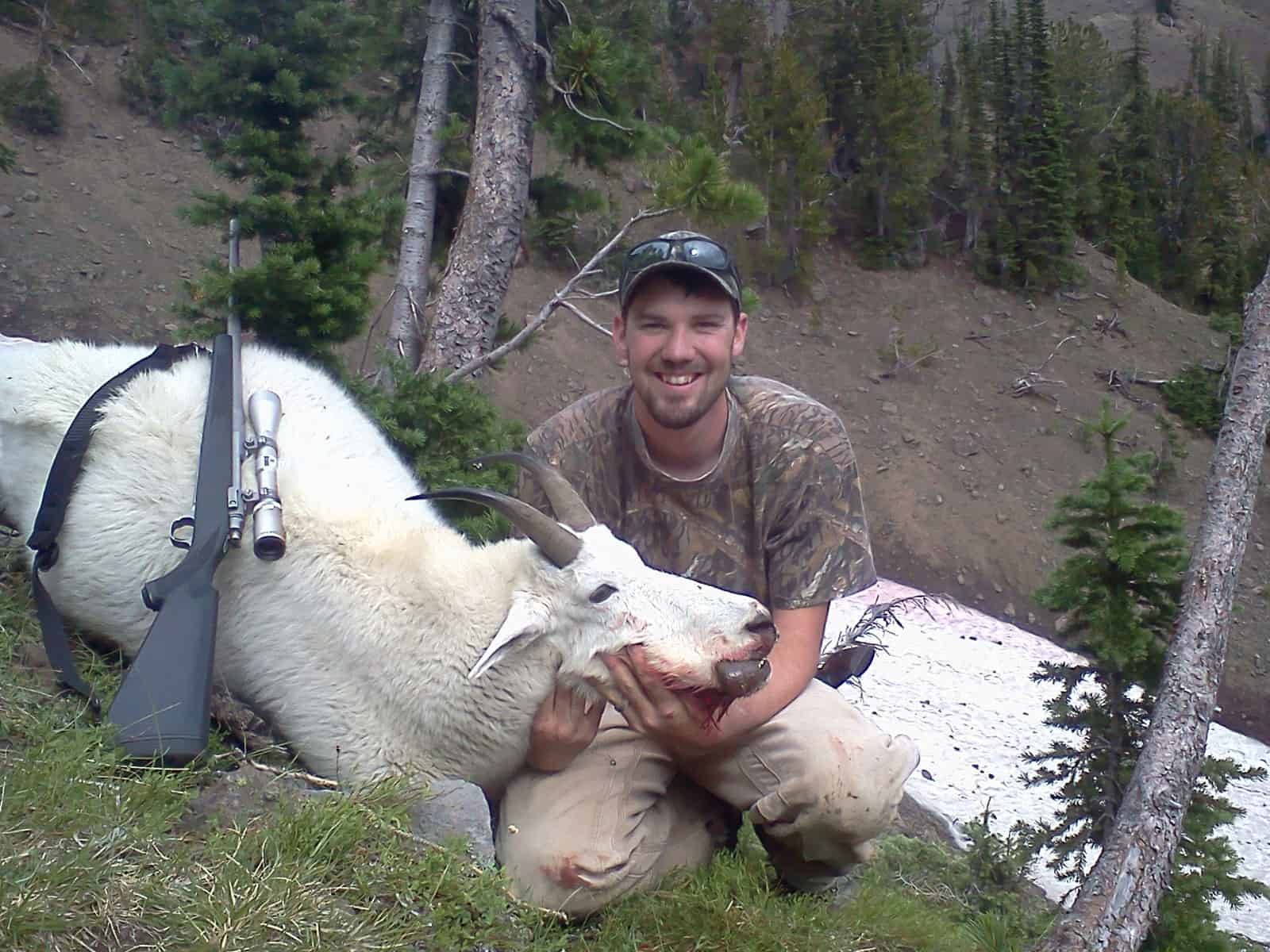
Michael Bost drew a mountain goat tag in 2011.
Close Calls – Backcountry Risks
Last year, Bost was fairly certain he had enough points to draw a sheep tag in Area 3, which is located just east of Yellowstone National Park and includes part of the Absaroka Range of the Rockies. So, when the Wyoming Game & Fish website confirmed it, he was ready and eager to start scouting in June for his September hunt.
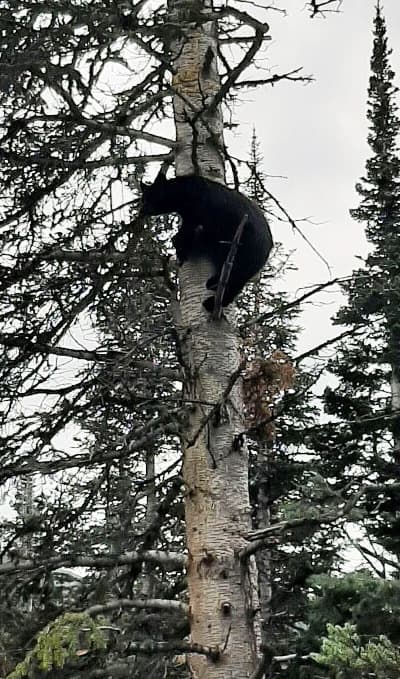
The hunters were surprised by a black bear cub and mother in nearby pine trees.
“We made scouting trips on horseback every weekend,” he said, “riding 14 or 15 miles into the mountains each trip.” By August, they settled on an area and chose a campsite for their two-week hunt starting September 1.
“Two weekends before opening day, dad and I were walking the horses through the camp,” he said, “when brush started breaking, and the air was filled with sounds of loud growls, roars and popping teeth.”
Each man instinctively reached for his .44 and prepared to face an irate grizzly. “We could see brush moving but no bear,” recalled Bost. In those terrifying seconds, they noticed a black bear cub perched 60 feet up a nearby pine tree.
“When mama bear climbed her own tree, we slowly walked the horses to the back of the camp and tied them off,” he said. “In a little while, the bears came down and went on their way.”
With the bears’ departure, the father-and-son team knew they’d dodged a bullet, but neither was prepared for the next one.
“Our plan was to head back up the mountain the next Sunday, set up the camp and be ready to start hunting on Wednesday when the season opened,” Bost explained. “But instead, I ended up in the emergency room on Saturday with horrible stomach pain.”
The doctor told Bost he had a large gall stone. Due to the pandemic, they wouldn’t be able to perform the necessary surgery for a few days. He further recommended that Bost cancel his hunting trip.
“I told him it wasn’t going to happen, and he said he figured as much,” said Bost. “So, he made me promise to stay on a totally fat-free diet during the trip or risk going down on the mountain.”
By the time Bost felt well enough to ride and hike, it was Tuesday—the day before the opener.
A Short, Successful Hunt
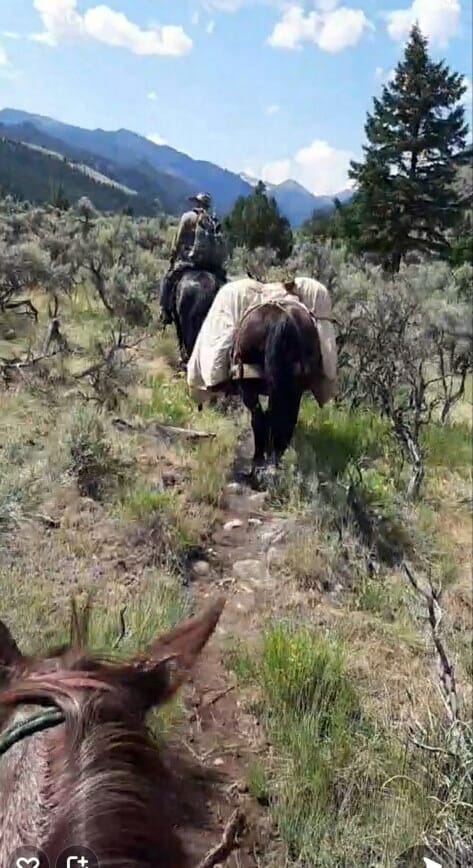
Prime hunting grounds are often remote. Reaching Bost’s base camp took five hours.
“It took about five hours to ride to the camp,” said Bost. “We crossed the same river eight times, and there were a couple of steep stretches where we had to lead the horses.”
With the horses fed and watered and the camp set, Bost turned in with plans for an early start in the morning.
“I planned to hike up the trail 20 minutes to a spot where I could get the glasses out and see what was going on,” Bost said. “It was about 6:45 a.m. when I left camp.”
The hunter walked slowly up a ridge, scanning as he moved. He stopped short when he caught movement in his left periphery. Two bighorn rams stood at 100 yards.
“They were downhill in some fairly open burnt timber, and I’d been moving so slowly and quietly they didn’t know I was there” he said. “I immediately laid down, so they wouldn’t see me.”
Bost set up his spotting scope and discovered that the two rams were actually seven. “I saw immediately that two of them were small and not worth looking at. Two others were mature, probably six to eight years old, and massive. The one I liked best was full curl with one lamb tip (a horn not broomed at the tip by age and use). The rangefinder said 107 yards, and I just waited until he gave me a broadside look.”
The bullet from Bost’s .300 mag sent the big ram into flight. “But he ran directly toward me,” the hunter said.
With the second shot at 47 yards, he went down for good. “At that moment, after 19 years of waiting, I was just shaking,” he said. “But then my heart sank when I saw 13 rams running up the opposite slope—a couple of them looked really nice. I’d never even got a look at them, and I thought I’d just made a rookie mistake. But then I quickly changed my mind; I had picked the ram I liked best, and I wouldn’t change it for anything.”
After a photo session and securing the ram, the father and son rested in camp and started the long trip back first thing the next morning.
Bost was in surgery for his gall bladder five days after coming off the mountain.
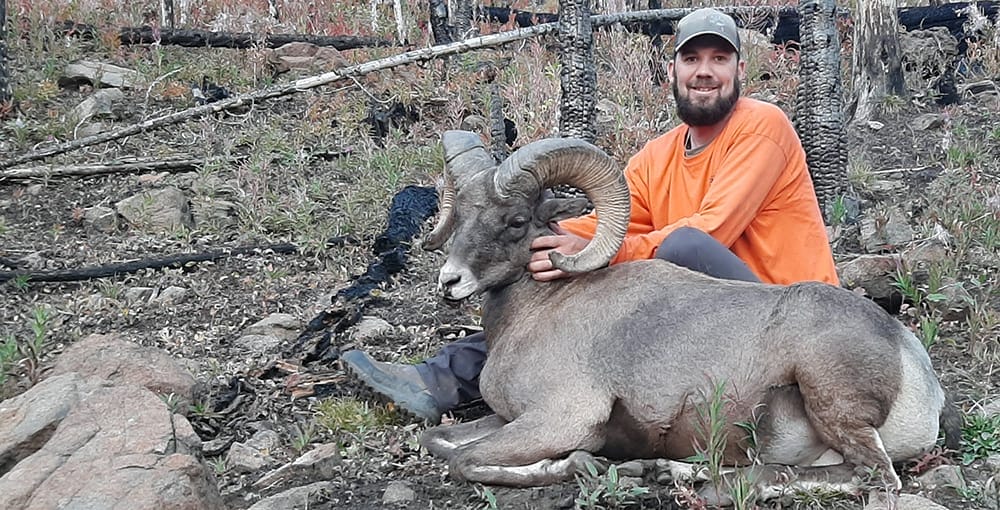
Michael Bost with his long-awaited bighorn sheep.
Are You a Union Member Who Loves the Outdoors?
If your answer is yes, you’re one of us! If you’re not already a USA member, join Bost and 320,000 fellow union sportsmen and sportswomen who are proud members of the USA!
Click Here – Join the USA



